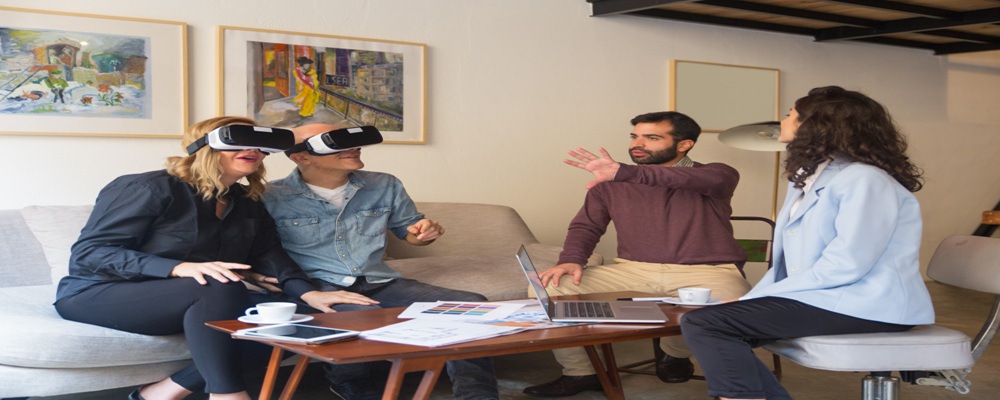
Business Benefits of AR VR Investment

Business Benefits of AR VR Investment
Augmented Reality (AR) and Virtual Reality (VR) have emerged as transformative technologies across industries, providing businesses with innovative ways to enhance customer experiences, improve operational efficiencies, and drive revenue growth. Increasing demand for immersive applications has led to the rapid rise of AR/VR app development, with businesses seeking reliable companies to stay ahead of the curve. This blog explores the key business benefits of investing in AR/VR development, supported by the latest use cases and industry trends.
1. Enhanced Customer Engagement and Immersive Experiences
One of the primary advantages of AR/VR app development is its ability to deliver engaging and interactive experiences. Businesses can leverage AR and VR to create immersive marketing campaigns, interactive product demonstrations, and virtual showrooms, significantly improving customer engagement and retention.
Use Case: Retail & E-commerce
Companies like IKEA and Sephora are using AR applications to allow customers to visualize products in their homes or try on makeup virtually before purchasing. By partnering with an AR/VR app development company, e-commerce brands can create virtual fitting rooms, reducing return rates and enhancing the overall shopping experience.
2. Streamlined Training and Skill Development
Traditional training methods often fail to provide real-world experience, especially in industries like healthcare, manufacturing, and aviation. AR/VR development enables businesses to create realistic training simulations that enhance learning outcomes and reduce operational risks.
Use Case: Healthcare & Medical Training
Leading hospitals and medical institutions are adopting AR VR applications to train surgeons in a risk-free environment. VR-based surgical simulations provide hands-on practice without the need for physical patients, improving precision and reducing errors.
3. Improved Remote Collaboration and Productivity
The rise of remote work has fueled the demand for virtual collaboration tools. AR and VR facilitate seamless communication and teamwork by creating virtual offices, digital twins, and 3D environments for meetings and project management.
Use Case: Corporate & Enterprise Solutions
Companies like Accenture and Microsoft use VR-powered workspaces to conduct meetings, onboarding sessions, and training programs. Businesses partnering with an AR/VR development company can develop customized virtual collaboration solutions, increasing efficiency and engagement among distributed teams.
4. Boosted Sales and Marketing Strategies
Traditional sales methods are evolving with AR and VR, allowing businesses to showcase their products and services in ways that were previously unimaginable. Immersive experiences increase conversion rates by providing customers with in-depth product insights before making a purchase.
Use Case: Real Estate & Architecture
Real estate firms leverage VR tours to offer potential buyers a walk-through experience of properties without requiring physical visits. An augmented reality development services provider can create interactive property visualizations, helping clients make informed decisions and accelerating sales cycles.
5. Enhanced Product Development and Prototyping
Product development often involves extensive testing and iteration, leading to high costs and time-consuming processes. AR and VR simplify prototyping by enabling designers and engineers to visualize, test, and modify products in a virtual environment before manufacturing.
Use Case: Automotive & Manufacturing
Automakers like BMW and Ford utilize VR for vehicle design, allowing engineers to evaluate different models and features without physical prototypes. AR VR solutions enhance product innovation while reducing material waste and development time.
6. Competitive Differentiation and Brand Innovation
Investing in AR app development companies enables brands to stand out in crowded markets. Augmented and virtual reality solutions provide unique value propositions, attracting tech-savvy customers and strengthening brand identity.
Use Case: Travel & Tourism
Tourism boards and travel agencies use VR-based travel previews to offer virtual destination experiences. Companies like Marriott Hotels have introduced VR hotel tours, allowing travelers to explore accommodations before booking.
7. Cost Savings and Risk Reduction
Implementing AR VR development can significantly cut costs by minimizing errors, improving safety, and reducing training expenses. Industries like construction and logistics benefit from AR-powered remote assistance and predictive maintenance solutions.
Use Case: Industrial & Manufacturing Safety
Companies are leveraging AR for real-time machine diagnostics and maintenance, reducing downtime and preventing workplace hazards. Smart wearables powered by AR provide workers with hands-free operational guidance, enhancing efficiency and safety.
8. Scalability and Future-Proofing Business Models
As AR and VR technologies evolve, businesses that invest in AR VR app development companies can seamlessly scale their solutions. Cloud-based AR VR applications enable real-time updates and integrations, ensuring long-term business adaptability.
Use Case: Education & Learning
Educational institutions and e-learning platforms are adopting VR-based immersive learning modules, offering students interactive lessons and virtual field trips. The integration of AR VR solutions in EdTech is revolutionizing traditional education methods.
Conclusion
The adoption of AR and VR is no longer a futuristic concept but a present-day reality reshaping industries. Businesses investing in augmented reality development services gain a competitive edge by enhancing customer engagement, optimizing training, improving collaboration, and reducing costs. Partnering with an AR VR app development company ensures access to cutting-edge technology, enabling businesses to create immersive solutions tailored to their needs.
As the demand for AR VR development continues to rise, organizations must explore opportunities to integrate these technologies into their operations. Whether in retail, healthcare, manufacturing, or education, the benefits of AR and VR extend beyond innovation—they drive tangible business outcomes. Now is the time to embrace AR VR solutions and unlock new possibilities for growth and success.